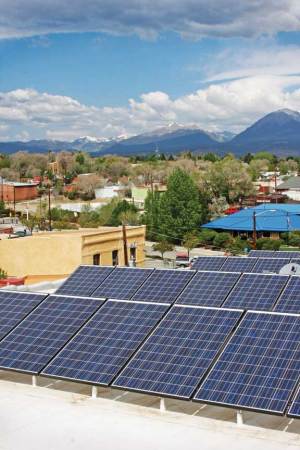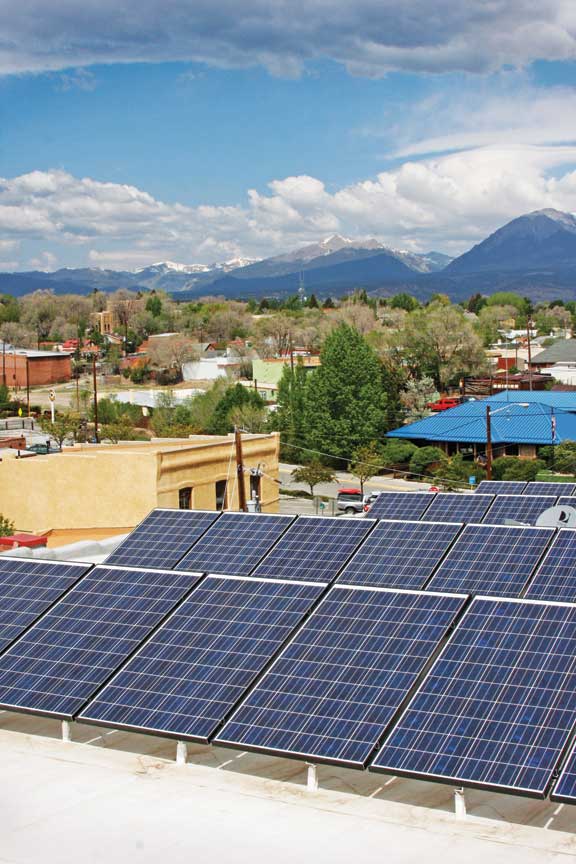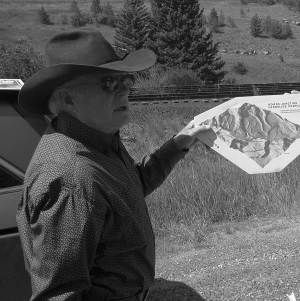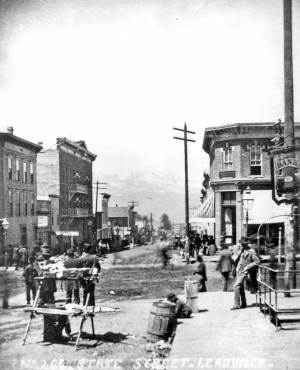by Ron Sering

Many places claim to be in Colorado’s sun belt, but Salida makes good on it. Estimates vary between 260 and 300 days of sunshine a year. That’s a lot of energy, and through a combination of improved technology and innovative funding, Salida is tapping into it.
From the top of the Palace Hotel, Salida’s oldest hotel and tallest building, the surrounding rooftops bristle with satellite dishes, evaporative coolers and power lines. And on an increasing number of them, including the hotel, photovoltaic (PV) modules glint in the sun.
“We wanted to have the lightest ecological footprint and did a lot of things to conserve energy and resources,” said Fred Klein, a former Santa Fe developer who, along with his wife Vicki, purchased the hotel in 2006. The Kleins brought the Salida landmark into the 21st century with a three-year renovation that includes historically faithful thermopane windows, water-efficient plumbing and a PV system.
The foundations of photovoltaic technology date back to the mid-19th century, when it was discovered that sunlight reacts with certain materials to produce electricity. Einstein himself earned a Nobel Prize for his work on the subject.
Though research and patents on various aspects of PV technology were developed over the next century, it wasn’t until the beginnings of the space age that PV technology became viable, first in spacecraft, then in pilot projects for more earthly applications. In 1963, the world’s most powerful PV generating array was a lighthouse in Japan producing over 240 kW(kilowatts).
The energy crisis of the 1970s sparked new interest in using PV to power homes and businesses, but it was hampered by costs as much as thirty times their current levels. Despite the drop, costs remain relatively high. A recent report from the Department of Energy estimates that PV systems incur a median cost of $5.30 a watt for systems smaller than ten kilowatts. Tim Klco of Peak Solar, who has installed many of the PV systems currently operating in the Upper Arkansas River Valley, stresses that there is no “typical” installation, and estimates the cost at between $3.50-$4.25 a watt.
The Palace Hotel generates ten kW of power that “basically supplies power to all the public areas of the hotel … and feeds the grid,” said Klein. “Feeding the grid” means selling power back to the local supplier, Xcel Energy, through Renewable Energy Credits.
Under the terms of Xcel’s Solar Rewards program, Xcel pays a monthly fee per generated watt to the owner of the PV arrays. Tax incentives sweeten the deal, and several other local businesses have joined in. Farther down the block is another of Salida’s historical buildings, the Hively Block, owned and operated by P.J. and Merrell Bergin. At the time, Xcel offered an upfront payment for RECs, as well as a monthly fee. “The deal we got was that they would pay $1.75 per installed watt,” Bergin said. “The ongoing REC payment is 4 cents a kilowatt hour. That amounts to about $30 a month, depending on the weather.”
The combined incentives can be the difference between cost-prohibitive and cost-effective. Bergin estimates that the combined incentives of RECs and state and local tax credits “worked out to be about fifty percent of the total cost.”
Less tangible but no less valuable is having the ability to provide a portion of your energy needs personally. “Generating power locally is much more efficient than, say, building a giant solar array and sending the power elsewhere,” Bergin said.
“As far as the solar, we wanted to reduce the utility bills, but at the same time it’s the right thing to do, saving energy,” said Jason Shelman, co-owner of Subculture Cyclery, west of the Palace Hotel. The bicycle sales and repair shop, a Salida mainstay, moved into its new digs three years ago and topped off a complete remodel with a small solar array.
Formerly, Xcel offered the RECs as an upfront rebate, based on the system’s estimated output. “They have since gone to a production-based REC,” said Klco. “Now, we place a net meter on the system, and Xcel pays a monthly REC to the owner of the system.”
Conventionally produced electricity is not getting any cheaper, and the sun continues to shine. Combined with the incentives, PV installation has proliferated in the area. “We have just finished two new installations,” said Klco, “one in Poncha [Springs] and one in Salida, that are waiting for net meters to be installed.” Still others are planned, both on- and off-grid, including an innovative partnership between the city of Salida and private financiers.
As a public entity, the city of Salida pays no taxes and is unable to take direct advantage of tax incentives. But the city has forged a partnership with a private third-party developer to install PV systems in several locations in the city. “When we brought the opportunity to the council a few years ago, they were very interested in pursuing a PPA for solar energy, as long as it made financial sense for the community,” said city administrator Dara MacDonald.
Under terms of the PPA, the third party funds and constructs the system on city property, and agrees to sell the generated power to the city at a guaranteed lower rate than the city would pay Xcel for conventional power. The third party is able to take advantage of both the tax credits and renewable energy credits.
Xcel has approved three facilities for construction in the spring of 2015, with four more under consideration. “The city of Salida is laying out no funds for this, and in no case would the city pay more for the alternative power than they would for conventional power,” MacDonald said.
The planned output for the three currently approved sites is 128 kW. “Additional sites have been preapproved by Xcel pending the planned reopening of the Solar Rewards program this month,” MacDonald said. Once completed, the seven facilities will produce nearly 385 kW of power.
“It’s a win-win for everyone,” Klco said. “With the energy credits and the tax credits, the private company can sell power more cheaply than the city can get from the utility company, and it helps green up the environment.”




